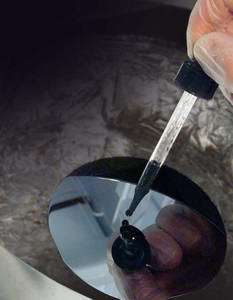Scientists 'PAD' their way to new metal-oxide film technology

University of California scientists working with a researcher from Washington State University at Los Alamos National Laboratory's Superconductivity Technology Center have developed a novel method for creating high performance, inorganic metal-oxide films using polymer-assisted deposition, or PAD. The breakthrough could pave the way for a greater use of metal-oxide films into the electronics manufacturing industry.
"The successful creation of both simple and complex metal-oxide films using PAD is part of the significance of this invention," said Dean Peterson, director of the Superconductivity Technology Center. "This technology provides a cost-effective approach to grow electronic and optical materials, which would find wide applications in any fields where the material is needed in the film form."
The PAD process uses a water-based solution to create a high-quality film of nearly any metal oxide. The films can be made from a single or several different metals with controlled atomic weight relationships. Amorphous, polycrystalline, or epitaxial films can be made with thicknesses from 10 nanometers to hundreds of nanometers or thicker. Using PAD, Los Alamos researchers have produced films of simple metal oxides, such as titanium dioxide and zinc oxide, and also complex metal oxides, such as strontium titanate and indium tin oxide.
Metal-oxides are emerging as technically important materials because of the wide variety of physical properties they possess, which make them attractive for applications such as photovoltaic devices, gas sensors, microelectronics and corrosion protection devices. However, the production of high-quality metal-oxide films with a desired chemical composition has been costly and challenging. Metal-oxide films are typically grown by physical or chemical-vapor deposition techniques that require a vacuum system. Both techniques deliver quality metal-oxide films, but the cost of deposition systems and the ability to coat films only on a flat surface have limited their potential applications. Chemical solution deposition methods, such as sol-gel, are less capital-intensive, but many metal-oxides cannot be deposited using this technique.
The PAD process distinguishes itself from other coating technologies because of its low cost and ability to coat large areas and irregular surfaces. The technique not only uses 100 percent of the source materials, but also has the capability to control the chemical phases, microstructures and physical properties of the materials deposited.
Bill Tumas, director of the Laboratory's Institute for Hydrogen and Fuel Cell Research said, "Perhaps the most promising aspect of this new technology is the potential diversity of materials that can be readily made. PAD has the capability to enable the rapid exploration of a wide range of new materials."
The development of the PAD metal-oxide film coating technology involved the expertise of a number of Los Alamos scientists, including Quanxi Jia, Yuan Lin, Haiyan Wang and Stephen Foltyn from the Superconductivity Technology Center of the Materials Science and Technology Division, and Mark McCleskey, Anthony Burrell and Gavin Collis from the Chemistry Division. The team also included Alexander DeQuan Li from the Chemistry Department at Washington State University in Pullman, Wash.
Source: DOE/Los Alamos National Laboratory
















